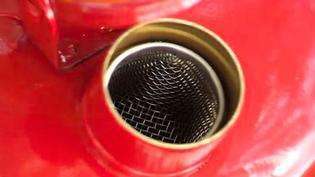The Consumer Product Safety Commission wants to see flame-arrestor safety devices added to plastic gasoline cans. A statement from the agency says the CPSC “is calling on the industry to regain the momentum that was lost in years past by designing their products to include this safety technology.”
 The small mesh device helps prevent the ignition of vapors inside gasoline cans.
The small mesh device helps prevent the ignition of vapors inside gasoline cans.Photo: wday.com
According to KSTP-TV, the ABC affiliate serving Minneapolis-St. Paul, a flame arrestor is a small device, similar to a mesh screen, in the nozzle of the can. The screen helps prevent vapors in the gasoline container from igniting. Such a device is required on metal gas cans such as those frequently seen on job sites, but there is no similar requirement for plastic gasoline cans. The portable fuel container industry believes about 15 million plastic gas cans are sold every year, KSTP reports.
Statistics compiled by the CPSC data shows that there have been at least 11 fatalities connected to pouring gasoline from a portable can where the can exploded. The agency estimates that about 1,200 emergency room visits have been associated with gas-can accidents between 1998 and 2012.
“The problem is, they can’t see the vapor coming out of the can and it’s the vapor that burns – it’s not the liquid but the vapor coming off the liquid that can ignite,” St. Paul Fire Department investigator Jamie Novak told KSTP-TV.
Novak suggested waiting 10 to 15 minutes for lawn equipment to cool down before trying to refuel in order to lower the risk of a possible heat source or spark’s coming in contact with fuel vapors.










